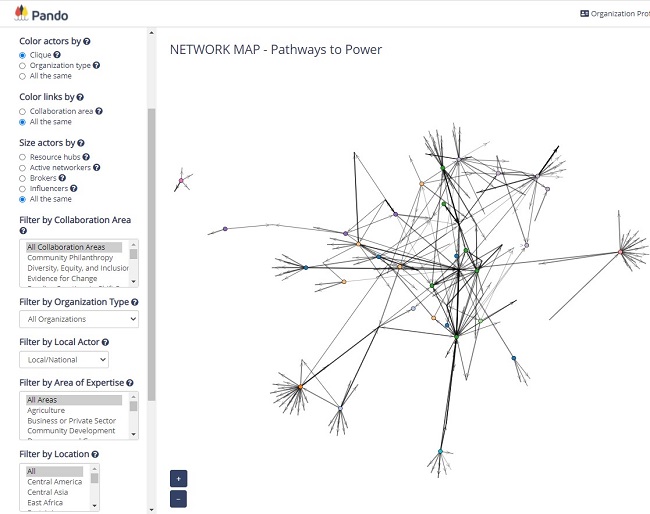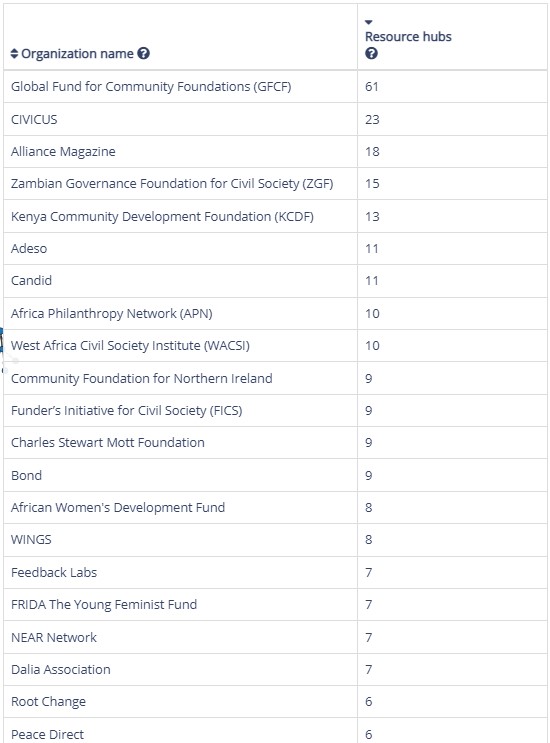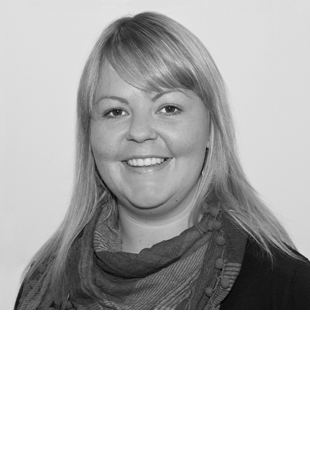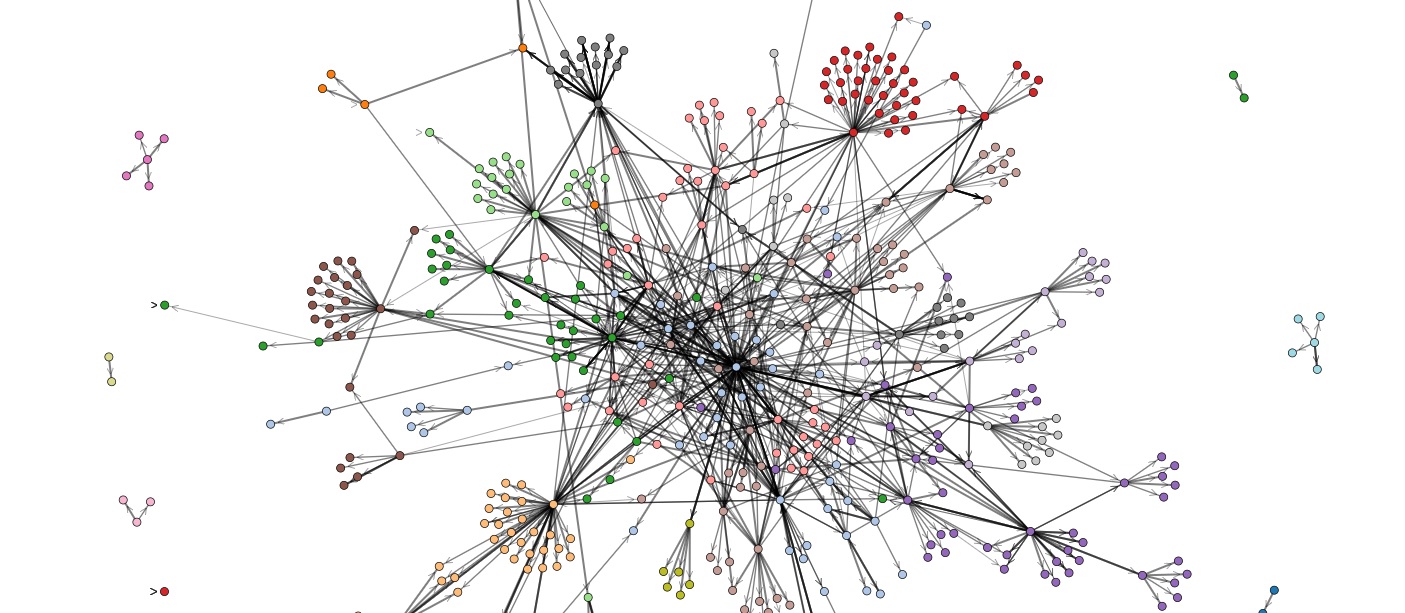Representation in the #ShiftThePower movement
16 Mar 2022
This blog is the second instalment in a four-part series exploring the #ShiftThePower network map. Follow along with the conversation, and see what was discussed in part 1 (Making the invisible visible: #ShiftThePower, mapping and meaning), part 3 (Collaboration in the #ShiftThePower movement) and part 4 (What’s next for the #ShiftThePower movement?)!
Over the past two years, participants in the #ShiftThePower movement have created a vibrant, living, and evolving network map of the community on the Pando platform, made up of more than 500 organizations and nearly 1,000 relationships. Originally created as a visual tool to understand both participation and representation within the #ShiftThePower community and to strengthen global collaboration, the network map also offers a way to grow the movement by centering the power of relationships.
Back in July 2021, the GFCF and Root Change co-hosted a global virtual convening to revisit the network map in the wake of the unprecedented disruption to aid and philanthropy that had taken place over the previous 20 plus months (watch the recording here). COVID-19, #BlackLivesMatter, #CharitySoWhite, #DecolonizingAid…these disruptions re-energized long-standing critiques about how the dominant funding systems operate, re-affirming the role of local civil society actors as essential frontline providers of humanitarian, economic or social assistance, and as defenders of human rights. But, we wondered, has anything really changed? Have new alliances and collaborations emerged or become stronger? How are they organizing? How and where are they being seen and heard, and their influence being felt?
The GFCF and Root Change teams caught up following the webinar to explore these questions together and to reflect on what we are all learning from the #ShiftThePower network map. Throughout this four-part blog series (see part one here), we’ll share some of this exchange between the GFCF and Root Change, and highlight opportunities to strengthen our collective work. This second instalment in the series zooms in on geographical and organizational representation and leadership within the movement.
 Root Change: Using filters in the #ShiftThePower map on Pando, we can see that there is currently significantly less representation from organizations that identify as local and / or national organizations. We see the greatest representation from INGOs and donor organizations and the least representation from businesses, government institutions and community based organizations. Let’s keep in mind that we are missing data from organizations that haven’t logged in to update their profiles on Pando.
Root Change: Using filters in the #ShiftThePower map on Pando, we can see that there is currently significantly less representation from organizations that identify as local and / or national organizations. We see the greatest representation from INGOs and donor organizations and the least representation from businesses, government institutions and community based organizations. Let’s keep in mind that we are missing data from organizations that haven’t logged in to update their profiles on Pando.
While the big picture narrative hasn’t shifted, there are some noteworthy differences since we looked at this same map in 2019. What we now see is the increased prominence of a group of national / regional actors such as Adeso, the Africa Philanthropy Network, Kenya Community Development Foundation, West Africa Civil Society Institute (WACSI) and Zambian Governance Foundation, that now feature prominently in the map. The work of these organizations and networks have been highlighted in newsletters and elevated on social media, and they have also been connected to others in the movement through active brokering.
GFCF: That seems right. High level, yes, it’s still dominated by international actors. But there is undoubtedly an enormous potential for Southern actors to emerge as prominent and more visible leaders in the movement. The map is one potential starting point but we are we going to have to make the case for organizations to want to map. Getting people to realize the power of visualizing their relationships (and appreciating that, in turn, relationships also equal power) is critical.
Root Change: This might be an area where the map isn’t an accurate reflection of what’s going on in the movement. It sounds like your team feels like there is a lot of activity among Southern actors in the movement, but those actors haven’t yet participated in the map. What do you think? Does the map give us an accurate sense that we need greater representation from Southern organizations?
GFCF: We think the map reflects the truth, but not the whole truth. There are many people doing what we might call “#ShiftThePower work”, but it is often in silos or specific networks. When looking at this map, we see the “Global North” silo, for example. Perhaps the way to do this is not to ask which of the organizations already on the map they already recognize, but rather, “Who else do you want with you in this community?” and then encourage those other partner and allies to join.
If you take social capital theory and the distinction it makes between “bonding” social capital (ties within a recognizable group), “bridging” social capital (ties between different groups who recognize a shared goal and organize accordingly) and “linking” social capital (ties that cross power differentials and are aimed at enabling, leveraging and making claims of others), then activities such as the map and the Pathways to Power Symposium are really about bridging and linking between different parts of the system. But as important is the strengthening of connections between groups that feel an affinity (that feel like they are an “us”), and then connecting them with the larger movement. We need to start using the language of influencing, showing up, and being visible as part of the community organizing and movement building work.
Root Change: In terms of the things that we can actually do, elevating national actors and drawing attention to their worlds and the folks they’re engaged with – it is one practical action that we shouldn’t ignore.
GFCF: You have to build relationships with partners, agree on core values and aspirations. It’s not just about getting people to map for the sake of it, but to bring them into the movement and see that there’s an opportunity here.
Root Change: Mapping is just an artifact of the actual movement building that is going on. The #ShiftThePower WhatsApp group is a great example of this, where there is a constant exchange of information, discussion and debate.
GFCF: Against all of these systemic barriers and resource constraints, we all have the ability to be more proactive – to be more generous with our connections and our knowledge. We have power here by clicking a few links and adding a few names, we can change what our map and our movement looks like. That to us is a really important message that we need to convey.
 Root Change: This theme of movement generosity continues to come up. The idea that in order to build a strong movement, we need to be generous with our relationships, ideas, and resources.
Root Change: This theme of movement generosity continues to come up. The idea that in order to build a strong movement, we need to be generous with our relationships, ideas, and resources.
Let’s continue our conversation about representation but shift gears to talk about “resource hubs.” These are the organizations that have been most frequently nominated by other organizations in the map. We see both international and local / national organizations emerging as resource hubs on the map. The greatest Southern regional representation is from Africa – East, South and West Africa. With that said, there is an opportunity to shift leadership to local / national organizations. Is there anything we want to share or explore related to resource hubs within the movement?
GFCF: Real collaboration between civil society organizations has always been hindered by that fact that they exist in what is a competitive funding system and people might be inclined to hold their connections close to their chest. But the fact that we see so many African resource hubs is really promising and demonstrates that the #ShiftThePower movement is starting to break new ground by enabling a sense of enlightened self-interest. Doing stuff together strengthens bonds and creates a bigger “us.”
From a funding perspective, this means that we – as a sector – need to find ways to fund systems and collaborations, not just individual organizations. What the map shows us is that by agreeing to work together, we can actually change this norm. If you want to change a system, it’s important for funders to think about how to create the conditions through which that can happen.
Root Change: There are movement participants working in every part of the world that we’re tracking. The greatest representation is in Southern and East Africa, North and South America, Western and Eastern Europe and, most recently, Southeast Asia. This might be because there are INGOs working in these areas and / or, by implication, that international aid still plays a big role: that’s something for us to dig deeper into.
There is the least representation in Central and East Asia. However, it’s becoming more difficult to say which regions are more or less engaged. That’s an exciting indication that we’re seeing increasingly global geographic representation in the map.
GFCF: The GFCF has recently started engaging more proactively with new partners in certain parts of the world, such as the Philippines and Francophone Africa (including Burkina Faso, the Democratic Republic of Congo and Togo). It will be interesting to keep an eye on this and to really reach out to some key actors there.
Interested in understanding more about the #ShiftThePower network map? Stay tuned for the next two parts in this blog series! For readers following along, we also encourage you to login to Pando and use the filters to make sense of the map for yourself. Are there opportunities that we missed for improved collaboration? Are there areas that we need to probe further? Do you see organizations that you would like to connect with to advance your work in the movement? Are you interested in participating in the map but don’t have a login? If so, reach out to info@mypando.org or info@globalfundcf.org.


